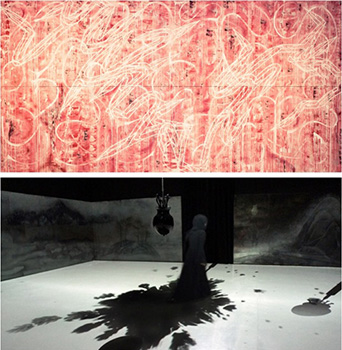April 21–23, 2017
The University of Chicago
The Center for East Asian Studies
1155 E. 60th St.
Room 310
Chicago, IL 60637
T 773 702 8647
Day 1
Friday, April 21, 6–8pm
Department of Art History
Keynote paper 1 + reception
Day 2
Saturday, April 22, 10:30am–5:30pm
Department of Art History
Keynote paper 2 + panel 1 + panel 2
Evening, 6–8pm
Logan Center for the Arts
Artist presentations
Day 3
Sunday, April 23, 10am–3:30pm
Department of Art History
Student workshop + plenary discussion
Writing and picturing are two fundamental human activities. In East Asia, the two have traditionally been entwined, with ink and brush playing central roles. In other areas of the world, their relationship was different. In the West, writing and picturing were considered separate, while in Islamic culture, the Koran gave the art of writing special status.
In modern Asia, calligraphy provided a vital platform for exploration in modernism and its continuing developments in recent years reflect its expansion into ink art and calligraphic abstraction across Asia. In view of this recent development, the symposium “Writing and Picturing” proposes to survey the state of scholarship and discuss the future directions in both museological and art-historical studies. The symposium organizers aspire to bridge the established studies of modernist art history and newly evolving contemporary art history while casting a wider geographical net beyond East Asia.
The symposium title refers to the East Asian coupling of writing and picturing (calligraphy and painting), while its subtitle indicates our intention to reexamine the cross-medial practices including their materials and tools, which have been thoroughly redefined and expanded from the ancient pair of “ink” and “brush.” Today, ink can be spray paint, digital pixels, video imagery, or even performative gestures, while brush to apply them encompasses spray cans, computer software, the camera, the artist’s body, or any other tools deployed by contemporary artists.
By providing a platform for presentations of new researches on various practices that merge writing and picturing in postwar and contemporary art, the organizers aim to create a watershed moment for culturally dynamic rethinking of those fundamental human acts.
Keynote speakers: Wu Hung, University of Chicago; Alexandra Munroe, Guggenheim Museum
Discussant at large: John Clark, University of Sydney
Artists: Jennifer Wen Ma; Enrico Isamu Ōyama
Professional presenters: Eugenia Bogdanova, Heidelberg University; Iftikhar Dadi, Cornell University; Maryam Ekhtiar, The Metropolitan Museum of Art; Joan Kee, University of Michigan, Ann Arbor; Jennifer Dorothy Lee, School of the Art Institute of Chicago; Yasuko Tsuchikane, The Cooper Union; Bert Winther-Tamaki, University of California, Irvine; Aida Yuen Wong, Brandeis University
The symposium “Writing and Picturing in Post-1945 Asian Art” is presented by the Center for the Art of East Asia and Center for East Asian Studies, both at the University of Chicago, and PoNJA-GenKon.
For details, please visit lucian.uchicago.edu.
Registration
The symposium is open to the public, but advance registration is required.
Please e-mail your name and affiliation to [email protected].
Funding
The symposium is made possible by the generous support of the Center for the Art of East Asia and the Center for East Asian Studies at the University of Chicago, PoNJA Explorers, and the ISE Cultural Foundation. Additional funding is provided by Jack and Susy Wadsworth, the Franke Institute for the Humanities, and SHIBUNKAKU. Special thanks to Misa Shin Gallery.
PoNJA-GenKon
Founded in 2003, PoNJA-GenKon, short for Post-1945 Japanese Art Discussion Group / Gendai Bijutsu Kondankai, is a scholarly listserv for those interested in postwar and contemporary Japanese art history.
*Image above: Top: Enrico Isamu Ōyama, FFIGURATI #103, 2015. Acrylic-based aerosol, acrylic-based marker and latex paint on canvas mounted on wood panels, 324 x 652 cm. © Enrico Isamu Ōyama. Photo: © Takahiro Tsushima. Bottom: Jennifer Wen Ma, The Furthest Distance in a Paradise Interrupted, 2016. Mixed media installation view at Qatar Museums Gallery Al Riwaq. Photo: Wen-You Cai.

